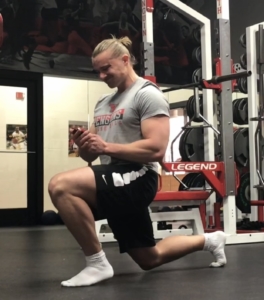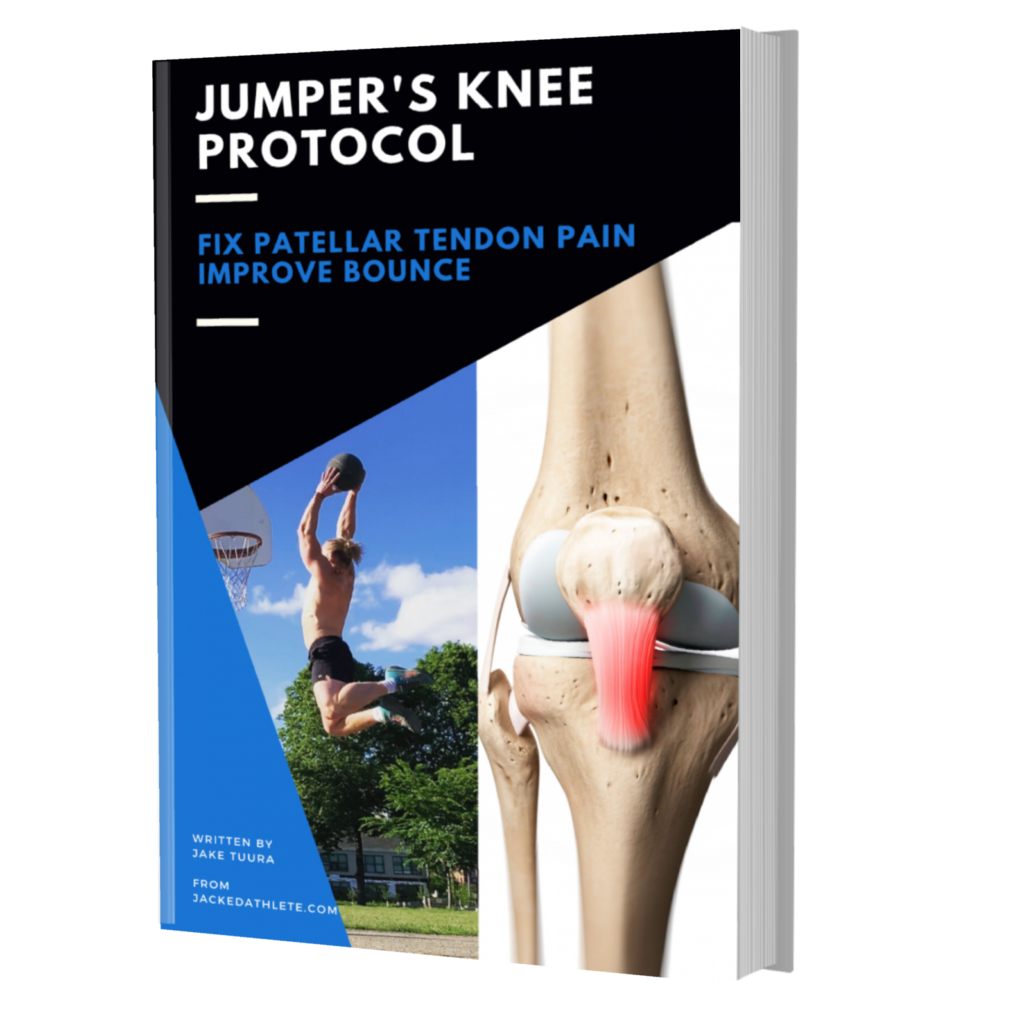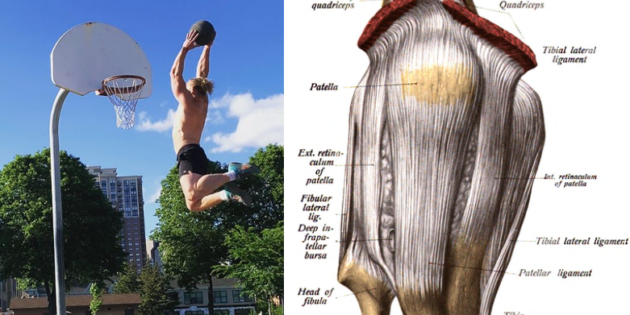I had Patellar Tendinopathy in my early 20s. For 3 years, I couldn’t dunk, squat, or play basketball without pain. Doctors told me to rest. This did not work. LOADING my tendons worked and now I rarely have issues. I wish I had known the following information years ago.
1) Tendons are not Ligaments
Tendons connect compliant muscle to stiff bone. Ligaments connect stiff bone to stiff bone.
LIGAMENTS: The stiffer, the better. A stiff ligament takes more force to break than a less stiff one.
TENDONS: It’s a little different. First of all, it’s very difficult to attach a stretchy structure (muscle) to a stiff structure (bone). Near the bone, the tendon is stiffer. Near the muscle, the tendon is stretchier. Through training, we can change the muscle end of the tendon, making it more or less stiff.
Unlike a ligament, (the stiffer the better), more stiffness of a tendon is not a win-win. A stiffer tendon can increase performance, best understood through this analogy:
Put a rubber band to a rock and pull (nothing will happen – the connector is too stretchy), put a rope to a rock and pull (rope will move some, rock will then move – this is better because the connector is stiffer), put a metal rod and pull (rock will move – the connector is very stiff). Stiff connector = better application of force. A stiff tendon (connector) allows for better force application from muscle (the pulling force) to bone (the rock).
But more tendon stiffness has a potential negative: increased chance of muscle injury.
If your tendon is stiffer than your muscle is strong, the tendon doesn’t extend and absorb shock upon impact so the muscle must lengthen abruptly (this is the cause of a lot of hamstring muscle injuries).
“As we increase performance capability of an athlete… that individual is also going to increase their risk for injury.”
Keith Baar, Ph.D.
2) Slow for Health, Fast for Performance
Slow loading of tendons causes relaxation and sliding of the collagen within the tendon. This decreases tendon stiffness.
Fast loading of tendons (jumping, cutting, sprinting) causes a stiffer tendon. Practice and competition in most sports will increase tendon stiffness (basketball, soccer, track and field, etc.)
Load tendons fast, increased stiffness (PERFORMANCE GAIN). Load tendons slowly, decreased stiffness (HEALTH GAIN).
HEALTH: Traditionally, slow eccentrics are used for tendon health or tendon rehab. This decreases the stiffness of the tendon. But you could also use isometrics and slow concentrics.

“It’s not about the eccentric component, it’s about the slow component. So you can do the same thing by doing slow shortening or you can do the slowest possible contraction which is an isometric contraction … all three work to improve health of the tendon.”
Keith Baar, Ph.D.
PERFORMANCE: Any jump, sprint, cut, or fast movement will help to increase performance by increasing stiffness and allowing for better force transfer from muscle to bone.
3) Once per day isn’t enough
To get tendons to respond to training, it doesn’t matter how far you load a tendon or how often (reps). What matters is how long. 5-10 minutes of exercise activates pathways. A full six hours are needed until cells are able to respond again.
It’s great for muscle and heart to run for three hours but the connective tissues have stopped adapting after 10 minutes. You need to do a separate session.
Very short periods of activity followed by long periods of rest are best for connective tissue.
WHAT TO DO
Here’s what I recommend: Do a short (5-10 minute) session spaced at least 6 hours apart from your scheduled lift for the day.
Or, if you’re not lifting and need something for tendon health/a base for performance, do this:
If there is no tendon issue, you can work mainly on performance in this extra session. This could be any dynamic movement that simulates your goal.

- For dunkers, jump rope for 5-10 minutes or do any jumping activity. I would suggest the landings be softened (box jump or band assisted jump) to minimize muscle damage.
- For other goals, use your imagination… I have a feeling my 10-minute Spikeball games during the day have helped the tendons involved in change of direction.
If there is a tendon or muscle issue, work mainly on health (slow movements). This could be slow ecc/con or isometric hold that put load on the area you wish to heal
- For patella pain, squat or split squat slow ecc/con or iso hold.
- For Achilles pain, calf raise slow ecc/con or iso hold, even try the squat or split squat.
If you are on a program like Hypertrophy Clusters or Vertical Jump Protocol, simply add an extra session, spaced at least 6 hours from the planned training for the day. The workouts in Clusters and Vertical Jump will stimulate the health & performance aspect of tendon again, so adding the extra session gives you an opportunity for your tendons to get even juicier.
These ideas come from Keith Baar. Podcast here, video here
Another video here
If you have Jumper’s Knee and have never lifted weights, do the ISO workout. If you have access to a weightroom, do the 1×20 program here




